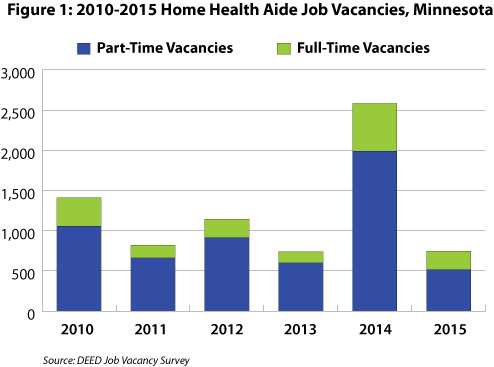by Chet Bodin
June 2016
Home Health Aides are similar to other Healthcare Support Professionals, but typically work in their client's home or in a care facility as opposed to a hospital or clinic. In addition to administering some medical care, Home Health Aides assist patients with daily activities like helping them dress or feed themselves.
The demand for Home Health Aides is increasing as a large number of Minnesotans age and require regular medical attention. Today there are approximately 27,550 Home Health Aides working in the state. This makes it the 20th largest occupation in the state, and it is projected to grow by 30.1 percent (9,254 jobs) from 2014-2024. This is the third highest projected growth rate among all occupations in Minnesota. However it still might not be enough given the projected increase of the state's population 65 years and older. The population of Minnesotans 65 years of age and older will increase by over 50 percent between 2014 and 2024 or nearly 400,000 people.
| 2014-2024 Proportion of Home Health Care Jobs to Population 65 Years and Older, Minnesota | ||||
|---|---|---|---|---|
| 2014 | 2024 | Numeric Change | Percent Change | |
| Home Health Care Jobs | 30,739 | 39,993 | 9,254 | 30.1% |
| Population 65 Years and Over | 780,142 | 1,173,707 | 393,565 | 50.4% |
| Proportion | 25:1 | 29:1 | -- | -- |
| Source: DEED Employment Projections; MN State Demographer | ||||
Despite the projected increase in Home Health Aides, their statewide proportion to the population 65 years and older will increase from one for every 25 senior residents to one for every 29. As it is, the projected occupation growth of 30.1 percent may result in a shortage of Home Health Aides as a generation of Minnesotans enter their golden years.
According to DEED's Occupations in Demand, Home Health Aides are in the top 40 of in-demand occupations in every economic development region throughout the state, and statewide it is the 21st ranked in-demand occupation. There are expected to be 16,000 job openings for Home Health Aides in Minnesota through 2024.
Employment in Home Health Care occupations is a great opportunity for those seeking part-time work regardless of professional experience. From 2010-2015, 78 percent of Home Health Aid job vacancies in Minnesota were for part-time work, averaging 956 part-time openings per year. The vast majority of Home Health Aide positions require less than a high school education, and skills are learned on the job. This allows nearly anyone to perform the type of work required, from family members to new job seekers to those with experience outside of healthcare. In addition to serving elders and those with disabilities, home health care offers a chance for workers of nearly any background to earn additional income.
The Home Health Care industry is growing. The industry paid nearly $500 million in wages in the first three quarters of 2015. The industry is projected to grow by 48.7 percent by 2024 or 11,291 workers, making it the second fastest growing industry in Minnesota. Many of the jobs added in the industry will be Home Health Aides. Further projections indicate that by 2035 more Minnesotans will be over 65 than under 18, signaling a long-term need for Home Health Aides. Overall, it's clear that the demand for Home Health Aides is on the rise and will remain high for the foreseeable future and can provide consistent, full- or part-time, long-term employment opportunities for many across the state.
| Regional Demand, Employment and Projections for Home Health Aides | |||||
|---|---|---|---|---|---|
| Region | Current Demand Rank | Median Hourly Wage | Estimated Regional Employment | 10-Year Percent Change | 10-Year Total Openings |
| Minnesota |  |
$11.99 | 27,550 | 30.1% | 16,190 |
| Central |  |
$11.29 | 3,770 | 33.1% | 2,860 |
| Northeast |  |
$12.01 | 2,320 | 21.7% | 1,300 |
| Northwest |  |
$11.89 | 1,540 | 22.4% | 1,420 |
| Southeast |  |
$11.13 | 3,460 | 21.1% | 1,210 |
| Southwest |  |
$11.03 | 2,200 | 17.2% | 1,370 |
| Twin Cities Metro |  |
$12.69 | 14,990 | 34.5% | 8,070 |
| Source: DEED Occupations in Demand, Occupational Employment Statistics, Employment Outlook | |||||
